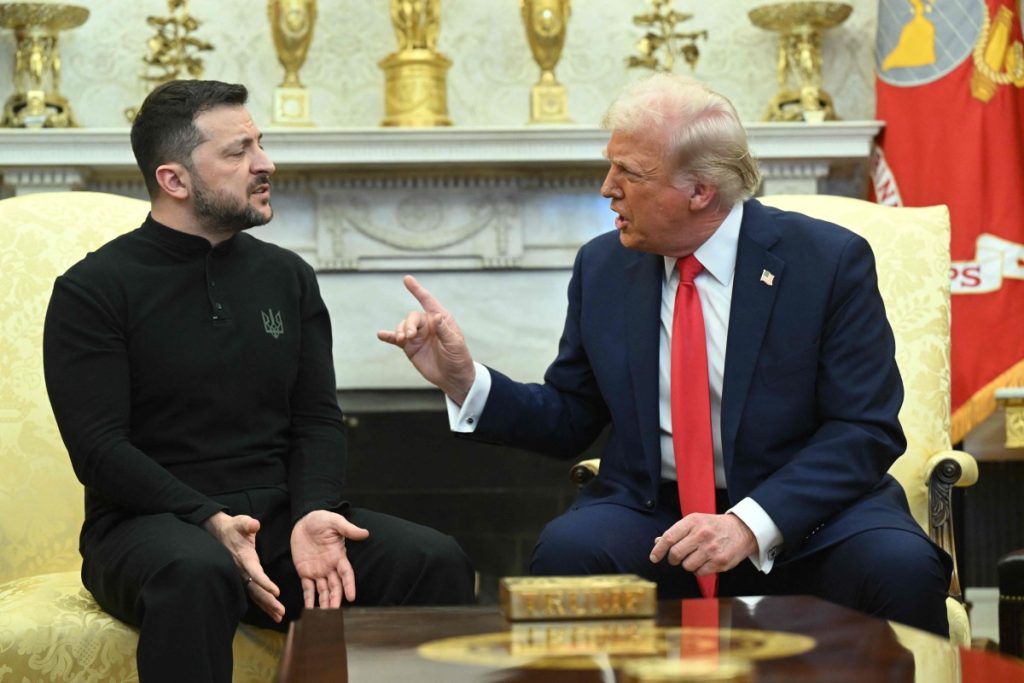Trump and Zelenskyy Clash in Explosive Oval Office Meeting Amid Tensions Over Ukraine Crisis
WASHINGTON — In a dramatic and high-stakes encounter on Friday, tensions between President Donald Trump and Ukrainian President Volodymyr Zelenskyy escalated into an explosive confrontation that left the room reverberating with raised voices. This meeting, which was supposed to be a diplomatic exchange with global implications, devolved into a heated shouting match. The dramatic altercation unfolded in front of cameras, becoming one of the most intense and public Oval Office confrontations in recent history.
Zelenskyy’s Visit to Washington Derails Amid Tensions
Zelenskyy, who arrived in Washington to sign a crucial agreement granting the U.S. access to Ukraine’s mineral resources, quickly found himself at odds with the American leadership. What was supposed to be a historic signing ceremony quickly fell apart as the Ukrainian president was fiercely criticized for his handling of the war. Trump, along with Vice President JD Vance, reproached Zelenskyy for his approach to the ongoing conflict with Russia, once again falsely attributing blame to the Ukrainian leader for a war that was instigated by Russian President Vladimir Putin’s full-scale invasion.

The meeting turned chaotic as Trump and Vance accused Zelenskyy of disrespecting both the United States and the Trump administration. Their explosive accusations derailed the signing ceremony, which was abruptly canceled, and instead of discussing the deal, Trump issued a terse statement while Zelenskyy departed from the room in the wake of the clash.
Trump’s Ultimatum: “Make a Deal or We’re Out”
In an extraordinary outburst, Trump delivered a stark ultimatum to Zelenskyy: “Make a deal or we’re out,” the U.S. president declared. “And if we’re out, you’ll fight it out. I don’t think it’s going to be pretty, but you’ll fight it out.” The high-pressure statement came as Trump continued to assert that Ukraine did not have the necessary leverage in its negotiations with Russia, particularly given the growing fear that the conflict could escalate into a global catastrophe.

Trump’s words, laden with frustration, painted Zelenskyy as playing a dangerous game, one that could ultimately lead to World War III. “You’re gambling with World War III,” Trump warned the Ukrainian president, underscoring the potential global ramifications of the ongoing conflict and casting doubt on the wisdom of Ukraine’s current strategies. The exchange, marked by escalating voices, indicated a deepening rift between the two leaders at a critical moment for Ukraine’s future.
Vance’s Role: Criticizing Zelenskyy’s Approach
Vice President JD Vance, who has been outspoken about his support for Trump’s diplomatic stance, waded into the fray, staunchly defending Trump’s strategy and attacking Zelenskyy’s actions. Vance pressed Zelenskyy, asking pointedly whether the Ukrainian president had ever expressed gratitude to the United States for its support.
“Mr. President, with respect, I think it’s disrespectful for you to come into the Oval Office and try to litigate this in front of the American media,” Vance declared, his voice rising. He pointed to Ukraine’s mounting manpower problems, accusing Zelenskyy of conscripting more soldiers to the front lines in an effort to keep the war going. “You should be thanking the president for trying to bring an end to this conflict,” Vance asserted, reinforcing the notion that Ukraine should be more appreciative of America’s role in the peace process.

As tensions mounted, Zelenskyy tried to interject, asking Vance if he had ever been to Ukraine to witness the widespread destruction firsthand. But before the debate could further escalate, Trump returned to the fray, chastising Zelenskyy for speaking as though the United States had no stake in the outcome of the war. “Don’t tell us what we’re going to feel. We’re trying to solve a problem,” Trump retorted, signaling that he was frustrated by the lack of cooperation in the room.
Zelenskyy Calls Putin a “Terrorist” Amid Ongoing War
Before the heated argument, Zelenskyy had made strong statements about Russian President Vladimir Putin, labeling him a “terrorist” responsible for atrocities in Ukraine. “I really count on your strong position to stop Putin,” Zelenskyy told Trump, emphasizing the importance of strong words and actions to curb Putin’s aggression. “He is a killer and terrorist, but I hope that together we can stop him,” Zelenskyy said, calling for more decisive action to prevent further escalation of the conflict.
In sharp contrast, Trump’s rhetoric surrounding Putin was markedly less critical. While he had previously described Zelenskyy as a “dictator,” he refrained from calling Putin the same. Trump maintained that he trusted Putin to “keep his word” in any peace talks, something Zelenskyy found troubling given the Russian leader’s track record. Trump repeatedly asserted that he was not “aligned” with Putin but rather focused on achieving peace for the good of the world, especially the United States.
The Unlikely Diplomatic Divide
The diplomatic divide between Trump and Zelenskyy was laid bare in this volatile encounter. Despite Zelenskyy’s appeal for U.S. support and intervention in the war, Trump’s rhetoric suggested a growing frustration with the Ukrainian president’s approach to the conflict. Trump’s call for a quick resolution and his willingness to cut ties with Ukraine if necessary raised doubts about the U.S.’s commitment to Ukraine’s cause.

In conclusion, the explosive meeting underscored a shifting dynamic in U.S. foreign policy toward Ukraine and Russia. While Trump has repeatedly called for a swift resolution to the conflict, his method of dealing with Zelenskyy – including harsh ultimatums and accusations – revealed a growing frustration with Ukraine’s handling of the war and raised questions about the future of U.S.-Ukraine relations.
Key Takeaways from the Shouting Match:
- Trump’s Ultimatum: The U.S. president told Zelenskyy that Ukraine must either reach a peace agreement with Russia or risk being left to fight on its own.
- Vance’s Criticism: Vice President JD Vance echoed Trump’s criticisms, urging Zelenskyy to show gratitude for America’s role in the peace process.
- Zelenskyy’s Struggle: Despite Ukraine’s dire need for continued international support, Zelenskyy found himself in a hostile environment, with little room to negotiate.
This clash in the Oval Office may have profound implications on Ukraine’s future, as the U.S. government’s approach to the war shifts and the pressure to end the conflict grows.


